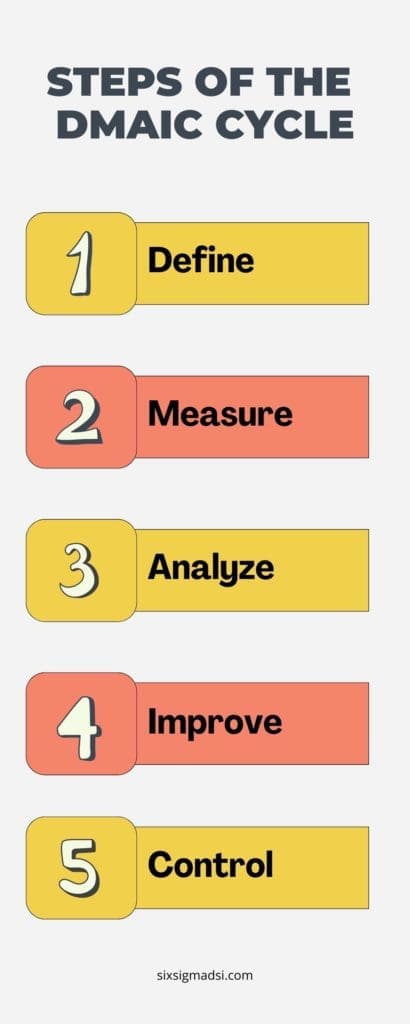Table of contents
A Tollgate Review process will help you determine if the goals in a DMAIC stage have been completed and whether you can move on to the next stage. A Six Sigma Measure phase Tollgate Review process is like a checkpoint at which the various team members meet with a project Champion and determine whether the work has been performed as indicated in the project plan and whether the objectives mentioned have been achieved.
Tollgates are used in Six Sigma to mark the path to success. The tollgates provide guidance for the project team, keeping them focused, on task, and within the project scope.
Three tollgates are located in each of the five phases of the Six Sigma DMAIC strategy. Each tollgate must be completed by the team before they can move on to the next phase, each tollgate has equal importance. Tollgate reviews are used to ensure that they have been completed.
The 15 Six Sigma Tollgates
Three tollgates are used in each phase of DMAIC. This is a quick overview of each as taught in Lean Six Sigma Black Belt.
Define phase tollgates
- Create a project charter The Charter gives a concise and clear summary of key information about the project. The project charter includes a business case, a problem statement, and the scope of the project.
- Voice Of Customer – This is a way to identify the customers who will be receiving the product or services that result from the review process. The teams also define the requirements and needs of customers.
- Map out the process. List the steps to deliver a service or product.
Measure Phase Tollgates
- Performance Indicator Identification – Specify the measures to be taken, with an emphasis on those that are at the front of the process.
- Data Collection Plan – This plan specifies how data will be collected, and defines the definitions and procedures.
- Baseline Performance Measurement – This gives an assessment of the current performance of the company’s process. This will then be compared with what happens when improvements are made.
Analyze phase tollgates
- Root cause potential – Teams brainstorm as many causes as they can to identify any that could contribute to the issue. It is important to include everything.
- Identify the most likely root causes. Teams will identify the causes that are the biggest contributors to a problem.
- Root cause critical – This reduces the list of root causes to the few most important that will have the greatest positive impact on the process if they are eliminated or reduced.
Upgrade phase tollgates
- Generate solutions – Review all possible solutions for each of the root causes.
- Select Solutions – Based on the importance of the solution to the client, company, and project, the team will select the best possible solutions. This decision will be driven by data.
- Implement solutions The team implements the solution through a plan of implementation that specifies when it will take place and any resources required.
Control phase Tollgates
- Monitor-and-Control Plan – The group creates a document that outlines how to measure the performance of solutions, and to ensure that new processes and procedures will be executed correctly.
- Response Plan – Create a plan for addressing potential problems.
- Plan for continuous improvement – Continuous improvement is an important concept in quality. A final tollgate is required for all projects. This creates a future plan of improvement.
This clear, logical process outlines the steps to create and finish a successful project. This is a reliable, repeatable process that gives teams a way of improving processes in any project.

Six Sigma Measure Phase Tollgate Review Process
- Has the Team Identified the Key Measures (inputs and Y’s)?
- Has a detailed Process Flow Chart/Map been developed to show Quick Wins (redundancies, Lean Improvements)?
- Has the “Input Map” been developed?
- How much time was spent on the development of the Input Map?
- Is the team confident that they have identified most of the KPIVs (Key Process Input Variables)?
- Are the KPOVs (Key Process Output Variables) described in measurable terms?
- What key measures identified indicate the performance of the business process (The Big Y’s and Little Y’s)?
- What are the agreed-upon definitions (specifications) of the high-impact characteristics (CTQs), defect(s), unit(s), and opportunities that will figure into the process capability metrics?
Was the Measurement System and the Data Verified?
- Has the team verified the stability and accuracy of the measurement process?
- Was a gauge R&R conducted? If not, how was the Measurement System Verified?
Process Variation Displayed and Communicated
- Has the team used control charts to display and communicate baseline variation in the KPIVs?
- Are there “Out of Control” situations? If so, how are they being dealt with?
Performance Baseline
- What is the current process performance baseline?
- How large is the gap between the current performance and customer-specified (goal) performance?

Tollgate reviews: How to manage them
The DMAIC method, which stands for Define Measure phase Analyze Improve, and Control offers organizations a variety of options in how they handle tollgate reviews. The five-phase approach provides a framework that project teams can use to analyze their current operations and make changes to improve efficiency and effectiveness.
Depending on the company, a lengthy meeting may be held at the end of each DMAIC stage. Some companies may have shorter meetings following the completion of a tollgate.
Tollgate reviews are designed to make sure that each tollgate is successfully completed. Each detail is taken into consideration. Teams must be careful to ensure that each tollgate has been completed.
- The project sponsor can review every step of the process, saving time and preventing redoing work.
- Discussion focuses on a single tollgate
- Schedule shorter meetings with ease
- Sponsors are kept active through frequent meetings
Invitations to meetings should include Green Belts and a Black Belt Mentor, as well as the Project Sponsor or Champion, along with the appropriate project team members.

How to prepare for a Six Sigma Tollgate Process Meeting
A successful tollgate process is dependent on preparation. To ensure an effective tollgate meeting, team leaders should adhere to guidelines.
- Send the documentation to the sponsor of the project days before the meeting.
- Set an agenda and decide on the best format to use for your discussion.
- Include time for attendees to be updated on any changes to the charter or scope of work, team members, etc.
- When meeting over the phone or the internet, make sure everyone has the correct connection details
- Make sure the software you use is compatible with everyone
- Remind the sponsor of which tollgates or tollgates are being reviewed
- Review the previous phases or tollgates, and then review briefly the current information including the tools and findings.
- If needed, request approval to proceed to the next tollgate.
- If necessary, request additional resources. Let the sponsor know the next tollgates and goals if approved
The sponsor should also inform the team about broader issues that they may not be aware of, make sure the project is within its scope, and progresses towards the project’s goal. Sponsors provide funding and staff support and are responsible for stopping a project that is no longer viable.



















